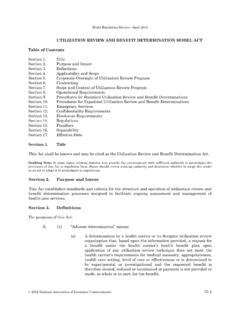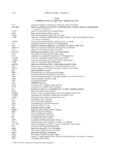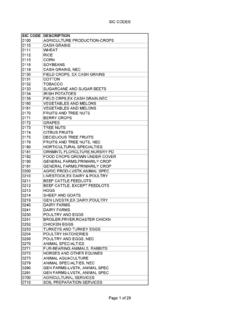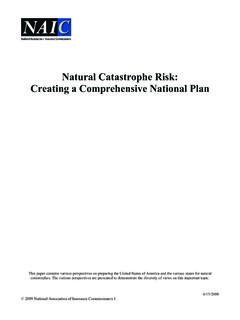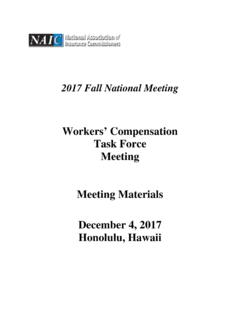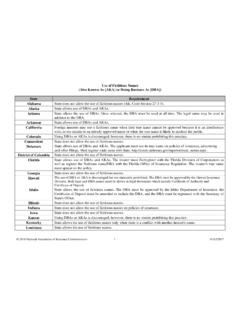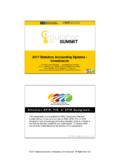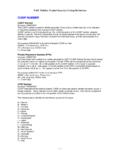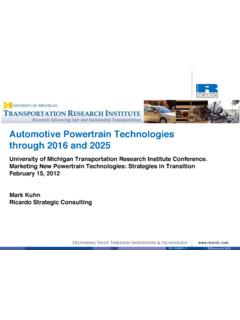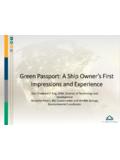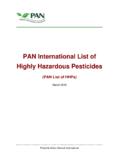Transcription of Pending Adoption by the A Committee LATF …
1 Pending Adoption by the A Committee LATF Adoption 12/1/2016 Actuarial Guideline XLVIII. Actuarial Opinion and Memorandum Requirements for the Reinsurance of Policies Required to be Valued under Sections 6 and 7 of the NAIC Valuation of Life Insurance Policies Model Regulation (Model 830). Background The NAIC Principle-Based Reserving Implementation (EX) Task Force ( PBRI Task Force ) serves as the coordinating body for all NAIC technical groups involved with projects related to the Principle-Based Reserves (PBR) initiative for life and health policies. The PBRI Task Force was also charged with further assessing, and making recommendations regarding, the solvency implications of life insurance reserve financing mechanisms addressed in the June 6, 2013 NAIC White Paper of the Captives and Special Purpose Vehicle Use (E) Subgroup of the Financial Condition (E) Committee .
2 Some of these reinsurance arrangements have been referred to as XXX/AXXX Captive arrangements, although not all such arrangements actually involve reinsurers organized as captives. In this connotation, XXX denotes the reserves prescribed by Section 6 of the NAIC Valuation of Life Insurance Policies Model Regulation (Model 830) while AXXX denotes the reserves prescribed by Section 7 of the NAIC Valuation of Life Insurance Policies Model Regulation (Model 830) and by Actuarial Guideline XXXVIII, The Application of the Valuation of Life Insurance Policies Model Regulation (AG 38). On June 30, 2014, the PBRI Task Force adopted a framework as found in Exhibits 1 and 2 of the June 4, 2014 report from Rector & Associates, Inc.
3 (the June 2014 Rector Report ). Exhibit 2 of the report included a charge to the Life Actuarial (A) Task Force (LATF) to develop a level of reserves (the Required Level of Primary Security ) that must be supported by certain defined assets ( Primary Security ). The level of reserves is to be calculated by a method referred to as the Actuarial Method. Another charge to LATF was to promulgate an actuarial guideline specifying that, in order to comply with the NAIC Actuarial Opinion and Memorandum Regulation, Model 822 ( AOMR ) as it relates to XXX/AXXX reinsurance arrangements, the opining actuary must issue a qualified opinion as to the ceding insurer's reserves if the ceding insurer or any insurer in its holding company system has engaged in a XXX/AXXX reserve financing arrangement that does not adhere to the Actuarial Method and Primary Security forms adopted by the NAIC.
4 The initial version of Actuarial Guideline XLVIII, Actuarial Opinion and Memorandum Requirements for the Reinsurance of Policies Required to be Valued under Sections 6 and 7 of the NAIC Valuation of Life Insurance Policies Model Regulation (AG 48) was developed in response to that charge, with an effective date of January 1, 2015. Coordination between this Actuarial Guideline and the NAIC Term and Universal Life Insurance Reserve Financing Model Regulation (Model ###). Subsequently, on January 8, 2016 the NAIC adopted revisions to the Credit for Reinsurance Model Law (Model 785). Among other things, the revisions to the NAIC Credit for Reinsurance Model Law (Model 785) provide commissioners with the authority to enact, by regulation, additional requirements for ceding insurers to claim credit for reinsurance with respect to certain XXX/AXXX financing arrangements.
5 On MM/DD/YYYY the NAIC adopted the Term and Universal Life Insurance Reserve Financing Model Regulation (Model ###) as the regulation permitted by the NAIC Credit for Reinsurance Model Law (Model 785). LATF subsequently received a charge to redraft AG 48 to make it as consistent as possible with the provisions of the NAIC Term and Universal Life Insurance Reserve Financing Model Regulation (Model ###). The current version of this Actuarial Guideline is the result. The following is an overview of the interrelationship between this Actuarial Guideline and the NAIC Term and Universal Life Insurance Reserve Financing Model Regulation (Model ###), and the regulatory strategy that led to the Adoption of each: 1.
6 The initial version of this Actuarial Guideline immediately established national standards for the use of XXX/AXXX. financing arrangements in an attempt to quickly set minimum standards based on the framework adopted by the PBRI. Task Force on June 30, 2014. This initial version applied to such reinsurance arrangements entered into on or after 1/1/2015. 2. The revised statute (the NAIC Credit for Reinsurance Model Law (Model 785) and a new regulation (the NAIC Term and Universal Life Insurance Reserve Financing Model Regulation (Model ###)) were then developed and adopted by the NAIC. 2016 National Association of Insurance Commissioners 1. Pending Adoption by the A Committee LATF Adoption 12/1/2016 3.)
7 Except as noted in #4 below, this Actuarial Guideline will cease to be effective, on a state by state basis, as individual states enact the NAIC Credit for Reinsurance Model Law (Model 785) and adopt the NAIC Term and Universal Life Insurance Reserve Financing Model Regulation (Model ###) to replace it. 4. Notwithstanding, it is anticipated that in a small number of states, the NAIC Term and Universal Life Insurance Reserve Financing Model Regulation (Model ###) will need to be adopted on a prospective basis only (that is, it will only apply to ceded policies issued on or after the effective date thereof). In those cases, this Actuarial Guideline will remain as the authority for ceded policies subject to this Actuarial Guideline but to which the NAIC Term and Universal Life Insurance Reserve Financing Model Regulation (Model ###), as adopted in a given state, does not apply.
8 So although its role might diminish, this Actuarial Guideline will remain an essential part of the regulatory framework for a small number of states for many years to come. 5. To ensure uniformity of treatment between states, companies, and ceded policies (whether governed by this Actuarial Guideline or by the NAIC Term and Universal Life Insurance Reserve Financing Model Regulation (Model ###) and to avoid confusion, this Actuarial Guideline is being updated, effective as of January 1, 2017, to make it as substantively identical to the NAIC Term and Universal Life Insurance Reserve Financing Model Regulation (Model ###) as possible. Authority, Avoidance, and Purpose The requirements in this Actuarial Guideline derive authority from Section 3 of the AOMR, or, after the Operative Date of the Valuation Manual, from Section 1 of VM-30 of the Valuation Manual.)
9 Both Section 3 of the AOMR and Section 1 of VM-30 provide that the commissioner has the authority to specify specific methods of actuarial analysis and actuarial assumptions when, in the commissioner's judgment, these specifications are necessary for an acceptable opinion to be rendered relative to the adequacy of reserves and related items. As contained in the framework adopted by the PBRI Task Force on June 30, 2014, this Actuarial Guideline defines new terms, such as Primary Security and Required Level of Primary Security, specifies the Actuarial Method used to calculate the Required Level of Primary Security, and specifies other requirements that must be followed when reinsurance is involved in order for the appointed actuary to render an actuarial opinion that is not qualified.
10 No statute, regulation or guideline can anticipate every potential XXX/AXXX captive arrangement. Common sense and professional responsibility are needed to assure not only that the text of this Actuarial Guideline is strictly observed, but also that its purpose and intent are honored scrupulously. To that end, and to provide documentation to the appointed actuary as to the arrangements that are subject to review under this Actuarial Guideline, the appointed actuary may request from each ceding insurer, and may rely upon, the certification by the Chief Financial Officer or other responsible officer of each ceding insurer filed with the insurer's domiciliary regulator that the insurer has not engaged in any arrangement or series of arrangements involving XXX or AXXX reserves that are designed to exploit a perceived ambiguity in, or to violate the purpose and intent of, this Actuarial Guideline.
